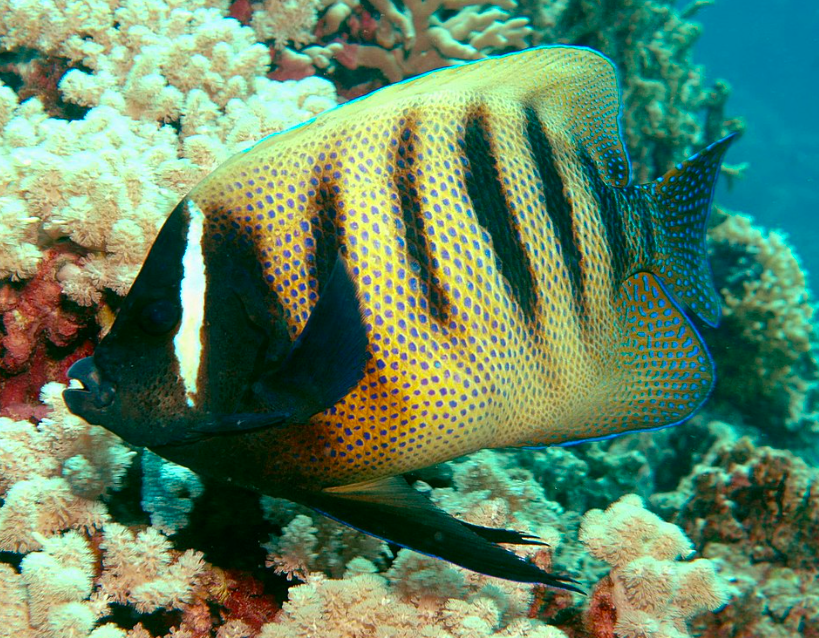 Image 1 of 1
Image 1 of 1


Angel - Emperor (juvenile)
The Emperor Angelfish (Pomacanthus imperator), often referred to as the Imperator Angelfish, is a stunning and popular species of marine angelfish known for its vibrant coloration and striking appearance. Here's some information about the adult Emperor Angelfish:
Appearance: Adult Emperor Angelfish are known for their striking colors and intricate patterns. They have a deep, compressed body with a primarily blue base color. Their dorsal and anal fins are outlined in electric blue, and they have a distinctive, bright yellow or orange mask covering their eyes and face. Additionally, they display vibrant vertical black and blue stripes on their body and rear portions, which gradually transition into a lattice-like pattern toward the rear of the fish. This complex and beautiful coloration is often why they are highly sought after in the aquarium trade.
Habitat: Emperor Angelfish are typically found in the Indo-Pacific region, including the Red Sea, the Indian Ocean, and the Pacific Ocean. They inhabit coral reefs and rocky areas, often at depths ranging from 3 to 15 meters.
Size: These angelfish can grow relatively large. Adult Emperor Angelfish can reach sizes of around 12 to 16 inches (30 to 40 centimeters).
Diet: In the wild, Emperor Angelfish primarily feed on a diet of sponges, tunicates, algae, and small invertebrates. In captivity, it's important to provide them with a diverse diet that includes high-quality marine flakes or pellets, as well as live or frozen foods like brine shrimp, mysis shrimp, and various types of marine algae.
Tank Requirements: Keeping Emperor Angelfish in an aquarium requires replicating their natural reef environment. This means providing live rock for grazing on algae and hiding places. Adequate lighting is important for any photosynthetic corals in the tank, as these angelfish may graze on algae.
Compatibility: Emperor Angelfish can be aggressive and territorial, especially when kept with other angelfish or similar-looking species. It's often recommended to keep them singly or in larger tanks with a variety of tank mates to help reduce aggression.
Captive Care: Consistent water quality, including stable temperature and salinity, is crucial for the well-being of Emperor Angelfish. They should be kept in established and mature aquariums to maintain stable conditions. Emperor Angelfish are best suited for larger marine aquariums due to their size and territorial behavior.
Before acquiring an Emperor Angelfish, it's important to do thorough research on their care requirements and ensure that you have the appropriate equipment and knowledge to provide them with a suitable environment. Additionally, be aware that these angelfish can be quite expensive and may require experience in keeping marine fish.
The Emperor Angelfish (Pomacanthus imperator), often referred to as the Imperator Angelfish, is a stunning and popular species of marine angelfish known for its vibrant coloration and striking appearance. Here's some information about the adult Emperor Angelfish:
Appearance: Adult Emperor Angelfish are known for their striking colors and intricate patterns. They have a deep, compressed body with a primarily blue base color. Their dorsal and anal fins are outlined in electric blue, and they have a distinctive, bright yellow or orange mask covering their eyes and face. Additionally, they display vibrant vertical black and blue stripes on their body and rear portions, which gradually transition into a lattice-like pattern toward the rear of the fish. This complex and beautiful coloration is often why they are highly sought after in the aquarium trade.
Habitat: Emperor Angelfish are typically found in the Indo-Pacific region, including the Red Sea, the Indian Ocean, and the Pacific Ocean. They inhabit coral reefs and rocky areas, often at depths ranging from 3 to 15 meters.
Size: These angelfish can grow relatively large. Adult Emperor Angelfish can reach sizes of around 12 to 16 inches (30 to 40 centimeters).
Diet: In the wild, Emperor Angelfish primarily feed on a diet of sponges, tunicates, algae, and small invertebrates. In captivity, it's important to provide them with a diverse diet that includes high-quality marine flakes or pellets, as well as live or frozen foods like brine shrimp, mysis shrimp, and various types of marine algae.
Tank Requirements: Keeping Emperor Angelfish in an aquarium requires replicating their natural reef environment. This means providing live rock for grazing on algae and hiding places. Adequate lighting is important for any photosynthetic corals in the tank, as these angelfish may graze on algae.
Compatibility: Emperor Angelfish can be aggressive and territorial, especially when kept with other angelfish or similar-looking species. It's often recommended to keep them singly or in larger tanks with a variety of tank mates to help reduce aggression.
Captive Care: Consistent water quality, including stable temperature and salinity, is crucial for the well-being of Emperor Angelfish. They should be kept in established and mature aquariums to maintain stable conditions. Emperor Angelfish are best suited for larger marine aquariums due to their size and territorial behavior.
Before acquiring an Emperor Angelfish, it's important to do thorough research on their care requirements and ensure that you have the appropriate equipment and knowledge to provide them with a suitable environment. Additionally, be aware that these angelfish can be quite expensive and may require experience in keeping marine fish.






